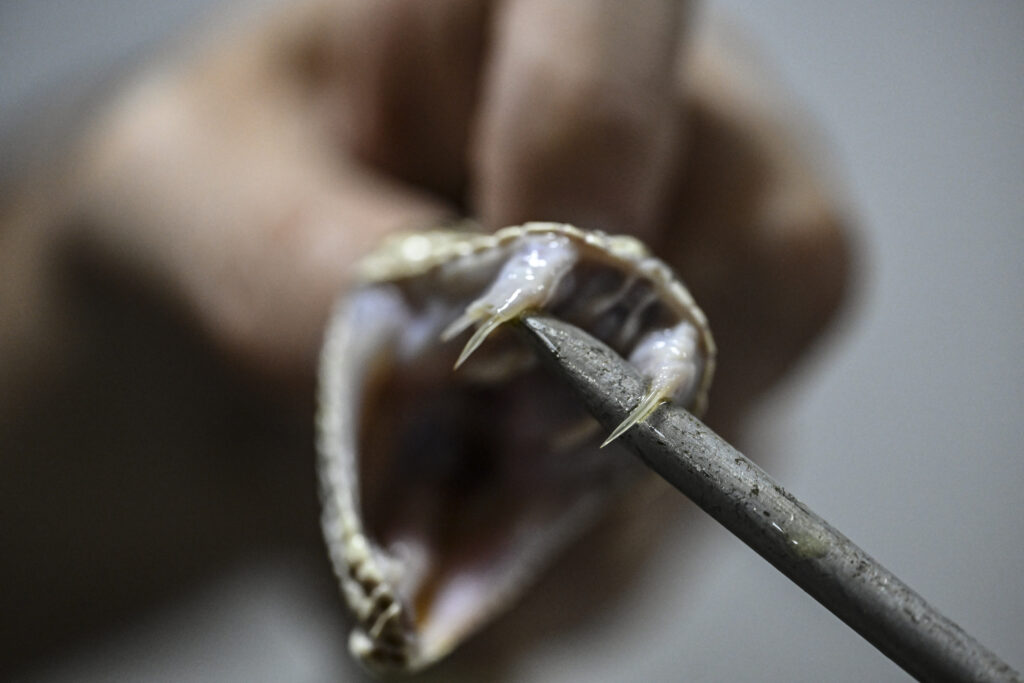
INQUIRER.net stock photo
CEBU CITY, Philippines – The distribution of snakebite treatments per barangay in Cebu is feasible. But an expert raised certain concerns.
Dr. Beethoven Bongon, a toxicologist at the Vicente Sotto Memorial Medical Center (VSMMC), spoke to CDN Digital about the concern of several residents calling for the distribution of anti-venom per barangay in response to the frequent sightings of king cobras in several areas.
READ MORE: King cobra sightings in Cebu City: Residents call for snakebite treatment in barangays
Bongon said that the distribution of snakebite treatments is possible. However, he noted certain concerns that have to be considered.
Who will administer the anti-venom?
First is the capability to administer the anti-venom.
“Feasible man siya pero ang problem diha, naa ba’y capable na muhatag? Kailangan man ka’g experts nga muhatag ana. Kay kanang anti-venom dangerous man pud na siya kun dili nimo mamonitor ang gitagaan [like] ang side effects. Taas mana siyag risk for adverse effects nga pwede sad ikamatay sa pasyente,” Bongon said on Tuesday, February 27.
(It’s feasible but the problem is if there are people who are capable of administering the anti-venom. You need experts to administer that. Because anti-venom is dangerous if you don’t monitor the person who is given like for side effects. It has high risk for adverse effects that can lead to the death of the patient.)
READ: Cobra bites: Where to get antivenom treatment when bitten by a venomous snake in Cebu
Bongon stated another concern that revolves around the decision-making process regarding the administration of anti-venom, as not all snakebites necessitate its use.
He further emphasized the need to determine who in the barangay decides if a victim requires anti-venom and whether there are trained personnel available to administer it effectively.
Bongon also raised questions about monitoring responsibilities, timing, and the qualifications of those administering the dose.
Additionally, the appropriate quantity of vials to be administered must be determined.
Anti-venom storage also a concern
Moreover, the toxicologist highlighted the importance of the barangay’s capability to store the anti-venom properly, as it requires specialized storage due to variations in formulation.
“Another factor is capable ba mo store ug anti-venom ang barangay? Kay naa mana siyay special storage pud based sa anti-venom… kay not all anti-venom is pareha ug formulation,” Bongon noted.
(Another factor is if the barangay has the capability to store the anti-venom. Because that has a special storage based on the anti-venom. Not all anti-venom has the same formulation.)
Moreover, Bongon stressed that not all venomous bites automatically result in “envenomation,” the process of venom injection. Thus, a thorough evaluation is essential before administering anti-venom.
Snakebite treatment availability
Another factor to reconsider regarding the distribution of snakebite treatment is the actual availability of these treatment in Cebu.
According to Bongon, as of the moment, only a few hospitals in the Philippines have stocks of anti-venom available, and their supply is also limited.
“Sa Cebu, wala. Kanang sa mga government facilities sa Cebu, for now wala pa gyud. I cannot say for the private hospitals kay kanang wala man koy control sa ila, but for the government hospitals, with regards sa anti-venom free ragyud na siya as long as naay available, ” he said.
(In Cebu, there’s none. Those with the government facilities in Cebu, for now, there’s really none. I cannot say for the private hospitals because we don’t have control on them. But for the government hospitals, with regards to the anti-venom, it’s really free as long as it’s available.)
He explained that the anti-venom available at VSMMC is polyvalent, effective against various cobras, including the King Cobra, Philippine Cobra, and Samar Cobra.
READ: What venomous snake has high-risk exposure in Cebu?
However, it is not commercially available due to its limited supply and its authorization under a Compassionate Special Permit (CSP) issued by the Food and Drug Administration (FDA). This permit restricts its distribution solely to qualified institutions like VSMMC.
Bongon clarified that the polyvalent antivenom in VSMMC does not possess full FDA approval, hence its restricted availability.
It can only be administered within VSMMC premises or similar institutions with the same authorization.
Furthermore, the Regional Institute for Tropical Medicine (RITM) prioritizes the distribution of PCAV (Purified Cobra Antivenin) to high-risk areas with frequent snakebite incidents, which do not include Cebu due to fewer reported cases.
READ: EXPLAINER: What to do when coming face-to-face with snakes
With the limited availability of snakebite treatments in Cebu, Bongon emphasized that residents should focus on preventive measures in the event of encountering or being bitten by a snake.
Firstly, once bitten, one must move away from the area where the snake is. Always assume that the snake that bit you is venomous.
Secondly, do not attempt to move the body where the wound is located to lessen the absorption of the venom.
Next, cover the wound with a clean cloth, not too tight, to avoid the wound from swelling.
Remember not to suck the venom. Lastly, avoid cutting anything from the wound to prevent further problems. /with reports from Niña Mae Oliverio
